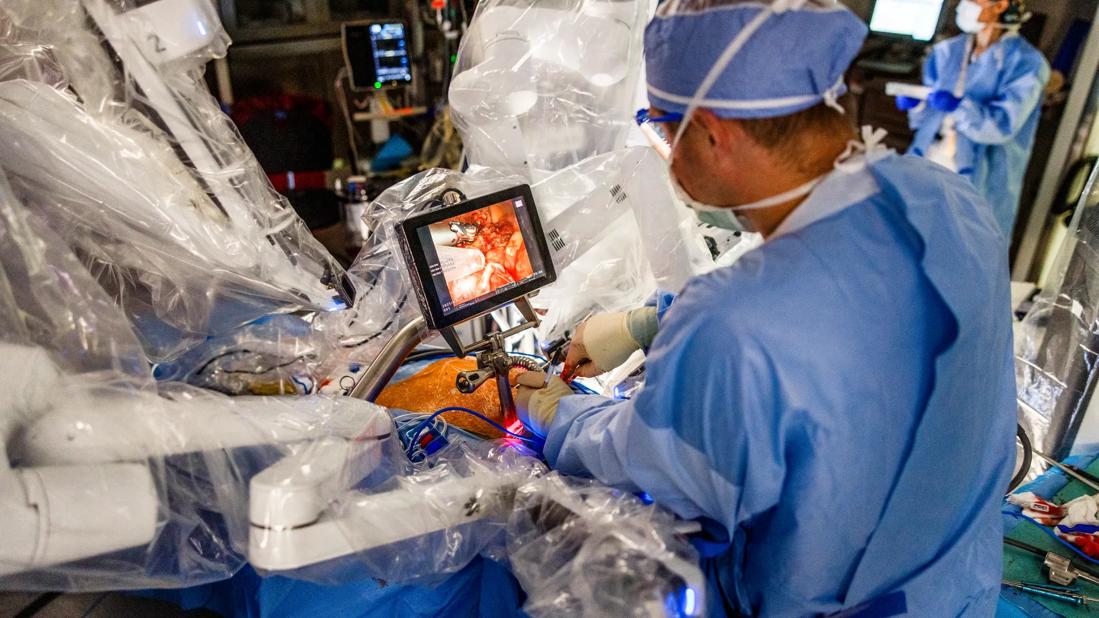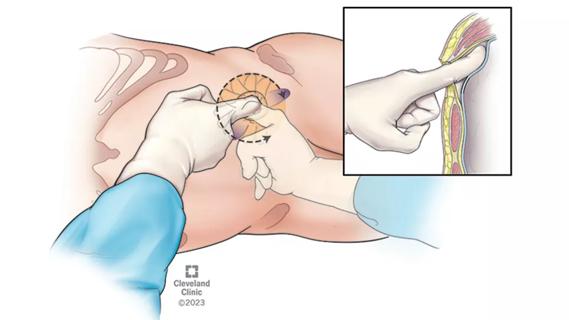Least-invasive open-heart AVR option to date yielded rapid recovery in all cases

Four patients who underwent robotically assisted aortic valve replacement (AVR) with transcervical access were able to resume an active life one week later without any restrictions, reporting low-level pain during recovery.
Advertisement
Cleveland Clinic is a non-profit academic medical center. Advertising on our site helps support our mission. We do not endorse non-Cleveland Clinic products or services. Policy
Cleveland Clinic cardiothoracic surgeon Marijan Koprivanac, MD, who performed the operations earlier this year, announced the results in a late-breaking presentation at the American Association for Thoracic Surgery annual meeting in May. The series is the first known report of the clinical application of transcervical robotic AVR.
“We are optimistic that this strategy could be a breakthrough for offering the benefits of surgical AVR without the lengthier and more painful recovery associated with current options,” says Dr. Koprivanac.
Surgical AVR (SAVR) has undergone rapid evolution in recent years with the aim of preserving advantages of an open-heart surgical approach — primarily complete debridement and removal of the diseased native valve, and potentially longer durability of the new implanted valve — while reducing invasiveness. “Although SAVR via sternotomy is still regarded as the gold standard for surgical candidates in need of an isolated valve procedure, currently it should be performed infrequently, if ever, because of the availability of excellent less-invasive options, including mini-sternotomy, right anterior thoracotomy, and transaxillary and robotic SAVR,” Dr. Koprivanac notes.
Robotic assistance for AVR is now in the vanguard of this evolution, conferring the advantages of smaller incisions, enhanced visualization and greater precision compared with other surgical methods. Combining robotics with a transcervical approach — potentially offering an even less-invasive option — is being explored by a few groups, but Dr. Koprivanac is unaware that it has been performed by others beyond feasibility studies in cadavers.
Advertisement
He first took an interest in this strategy after learning to perform transcervical thymectomies while in cardiothoracic surgical training. Access is through a small incision in the neck, without need for a thoracotomy or sternotomy incision.
“The transcervical approach is well suited to AVR, as it offers an excellent view of the aorta and aortic valve from above,” Dr. Koprivanac explains.
He developed his novel technique on human cadavers, in an anatomy lab at Cleveland Clinic Lerner Research Institute, using a mammary retractor and then a specialized transcervical retractor. He soon brought in some of his surgical colleagues and team. After demonstrating feasibility on some 20 cadavers, they started offering the procedure to patients at Cleveland Clinic.
The procedure involves four incisions. The main one, for robot entry, is placed at a neck crease to minimize scar visibility, similar to the incision in thyroidectomy patients. Placement of the other three small incisions is detailed in Figure 1. Decalcification and debridement of the aortic annulus is performed as needed, and the new valve sutured in. Figure 2 presents an artist’s rendering of a key step in the procedure.


The four patients who underwent the procedure were aged 60 to 74 years. The replacement valves used were the Perceval L in one patient and the Inspiris Resilia #25 in three patients.
The average cross-clamp time was 140 minutes. Postoperative discharge was at 3 days, 4 days (two patients) and 6 days (in a patient who developed complete heart block and ventricular dysfunction, requiring pacemaker implantation).
Advertisement
A local anesthetic was injected when the incision was closed at the robot entry sites. Postoperatively, all patients reported minimal pain and were managed with acetaminophen and ibuprofen unless additional procedures were needed. Patients had no restrictions, from a chest wall healing standpoint, a week after discharge, with one patient reporting that he had resumed running in the gym at that point. Another patient was back to his farmwork at week 3 after surgery. “These types of activities are unimaginable so soon after other AVR approaches, even minimally invasive ones,” says Dr. Koprivanac.
“This is an important advance in cardiac surgery — completion of a surgical aortic valve replacement with no incisions in the chest,” notes Marc Gillinov, MD, Chair of Thoracic and Cardiovascular Surgery at Cleveland Clinic.
Chair of Cardiovascular Medicine Samir Kapadia, MD, concurs. “This is a great advancement in minimally invasive surgical treatment for aortic stenosis,” Dr. Kapadia says. “This surgery may be preferred by patients if it delivers similar safety and efficacy as other, more-invasive surgeries.”
Dr. Koprivanac and his colleagues are continuing to offer this new approach to qualified patients who require an isolated aortic valve procedure.
“The procedure is getting easier as we learn from each patient,” Dr. Koprivanac says. “With experience, we are refining techniques — such as optimal port placement and level of valve introduction — and becoming more efficient. As we have proved the safety of the procedure, reducing cross-clamp times is the main goal now.”
Advertisement
He and his colleagues are also exploring designs of new instruments and sutures — and adapting existing ones — to facilitate the careful manipulation required in a very tight space.
Reducing the cross-clamp time to 90 minutes — and ideally to around 1 hour — is an important goal, and Dr. Koprivanac expects they can reach this target once the operation has been streamlined. “Our first priority is always safety, so we are proceeding cautiously to ensure a good outcome in each patient,” he says.
He adds that the potential of this operation is that patients might be able to be discharged on day 2 after the surgery. Although some patients in this series appeared ready for discharge on postoperative day 2, he notes, they were kept longer for observation owing to the novelty of the procedure.
Once Dr. Koprivanac and colleagues develop an efficient technique they are satisfied with, they intend to standardize it for reproducibility by other surgeons, but he says this will likely remain a procedure of highly specialized centers.
“Seeing how these first patients’ experience and recovery were so much better than with current approaches, we are highly motivated to perfect this technique to benefit more of our patients,” he concludes.
Advertisement
Advertisement

First single-port renal vein transposition reduces recovery time and improves outcomes

Rare pregnancy complication can lead to fetal demise

Approach offers a ‘middle ground’ between radical prostatectomy and active surveillance

The low anterior access approach using the single-port robot is gaining attention within the field

Center touts the benefits of neonatal MIS, trains others on the approach

Applications, outcomes and untapped potential

Case highlights the benefits of a minimally invasive approach

Pioneering and refining the approach in pyeloplasty, nephrectomy and more